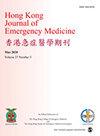Telemedicine communication using instant messaging technology improves pre-hospital triage in high mountain train disasters
IF 0.8
4区 医学
Q4 EMERGENCY MEDICINE
引用次数: 2
Abstract
Background: Differences between pre-hospital triage by an emergency medical technician and Simple Triage and Rapid Treatment triage (START) by emergency staffs often affect manpower management and aggravate the chaos condition of emergency room. Objectives: Under the assistance of instant messaging, the authors aimed to identify ways of improving triage differences between emergency medical technician triage grading and Simple Triage and Rapid Treatment triage grading by emergency staffs. Methods: Recorded photographs of all patients were reviewed by a smartphone. We categorized patients according to three triage conditions: group 1, accident scene on-site or instantaneous Simple Triage and Rapid Treatment triage by the emergency medical technician; group 2, triage under Simple Triage and Rapid Treatment grading by emergency staffs; group 3, re-triage with START grading using recorded photographs, Glasgow Coma Scale, and vital signs when these patients were arrived in emergency room. The Wilcoxon Signed-Rank test, Spearman rank correlations, and Kruskal–Wallis test are employed to test differences among the groups. We used risk estimates with odds ratios and the chi-square test to statistically analyze the differences in triage grading. Results: Statistical analysis found conflicting results among Wilcoxon Signed-Rank test, Spearman rank correlations, and Kruskal–Wallis test. The difference in triage grading between groups 2 and 1 was greater than that between groups 2 and 3 (odds ratio, 6.473; 95% confidence interval, 1.693–24.470; p-value < 0.05). Conclusion: Transferred photographs combined with Glasgow Coma Scale and vital signs can help us to understand the real situations of patients. With instant messaging applications, it is possible to make more precise pre-hospital or instantaneous triage.使用即时通讯技术的远程医疗通信改善了高山列车灾难中的院前分诊
背景:急诊技术人员的院前分诊与急救人员的简单分诊和快速治疗分诊(START)之间的差异往往会影响人力管理,加剧急诊室的混乱状况。目的:在即时通讯的帮助下,作者旨在确定如何改善急救技术人员分诊分级与急救人员简单分诊和快速治疗分诊分级之间的分诊差异。方法:通过智能手机查看所有患者的记录照片。我们根据三种分诊条件对患者进行分类:第一组,事故现场或即时简单分诊和急救技术人员的快速治疗分诊;第2组,急救人员按简易分诊和快速治疗分级进行分诊;第3组,使用记录的照片、格拉斯哥昏迷量表和这些患者到达急诊室时的生命体征进行START分级的重新分诊。采用Wilcoxon符号秩检验、Spearman秩相关性和Kruskal–Wallis检验来检验各组之间的差异。我们使用比值比和卡方检验的风险估计来统计分析分诊分级的差异。结果:统计分析发现,Wilcoxon符号秩检验、Spearman秩相关性和Kruskal–Wallis检验的结果相互矛盾。第2组和第1组之间的分诊分级差异大于第2组与第3组之间的差异(比值比,6.473;95%置信区间,1.693–24.470;p值 < 结论:转移照片结合格拉斯哥昏迷量表和生命体征可以帮助我们了解患者的真实情况。通过即时消息应用程序,可以进行更精确的院前或即时分诊。
本文章由计算机程序翻译,如有差异,请以英文原文为准。
求助全文
约1分钟内获得全文
求助全文
来源期刊

Hong Kong Journal of Emergency Medicine
EMERGENCY MEDICINE-
CiteScore
1.50
自引率
16.70%
发文量
26
审稿时长
6-12 weeks
期刊介绍:
The Hong Kong Journal of Emergency Medicine is a peer-reviewed, open access journal which focusses on all aspects of clinical practice and emergency medicine research in the hospital and pre-hospital setting.
 求助内容:
求助内容: 应助结果提醒方式:
应助结果提醒方式:


